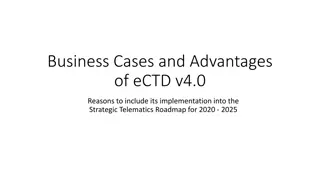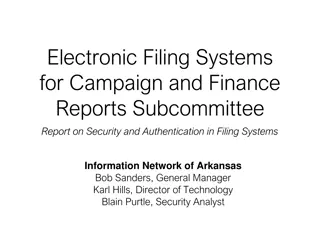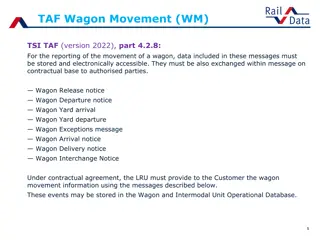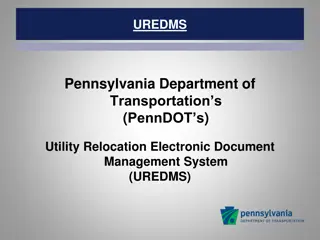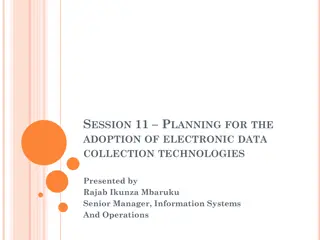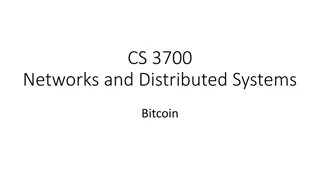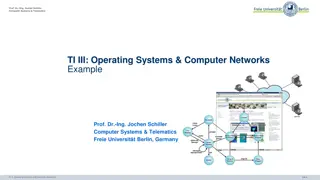Electronic Data Management: Telematics Evolution Benefits
The evolution and benefits of telematics in electronic data management. Learn how telematics impact driver performance, provide proactive insights, and drive competition through data transparency and real-time coaching.
Download Presentation

Please find below an Image/Link to download the presentation.
The content on the website is provided AS IS for your information and personal use only. It may not be sold, licensed, or shared on other websites without obtaining consent from the author.If you encounter any issues during the download, it is possible that the publisher has removed the file from their server.
You are allowed to download the files provided on this website for personal or commercial use, subject to the condition that they are used lawfully. All files are the property of their respective owners.
The content on the website is provided AS IS for your information and personal use only. It may not be sold, licensed, or shared on other websites without obtaining consent from the author.
E N D
Presentation Transcript
Electronic Data Management Tim Brewster Matt Daecher President, DCG AVP, Loss Control & Recovery Classified as General
What is Telematics & the Evolution Benefits of Telematics TODAY S AGENDA Evaluating & Controlling Performance How Data Can Affect Insurance Classified as General
What is Telematics? Telematics is a very broad term Sensor communications with external entities For this presentation's purpose: Vehicle-based information that can provide insight into vehicle operations & driving behaviors Allows for pre-incident intervention measures when indicated Classified as General
Data Provided By Telematics Vehicle Operating Information Location Cameras Fuel Faults Speed Driver insight consumption Tire pressure Engine codes Braking Acceleration Idling Classified as General
Evolution of Vehicle-based Technology Integration of Components Vehicle Diagnostics Computer Intelligence GPS Cameras Evaluating Driver Performance Classified as General
Benefits of Telematics Better understand your company performance CAUSE OF COLLISIONS CHANGING BEHAVIOR 1 Vid1 Major Collision 29 Driver 95% Minor Damage or Near Collisions Environment 30% Vid2 Coaching drivers to success 300 Vehicle 10% No-Damage Risky Incidents Vid3 Driver Behavior Improve auto liability & workers compensation performance Distraction Speed Awareness Limited Visibility Road Design Weather Blind Spots Tire Failure Mechanical Failure Changing risky behaviors prevents future collisions Source: Accident Research and Safety Report, Haddon Matrix Source: H.W. Heinrich, Industrial Accident Prevention: A Scientific Approach Increase defensibility of operation Better Control of Your Outcomes! Improved operating efficiency Classified as General
Telematic Impact: Driver Performance Individual driver metrics provides proactive information on driver behaviors Timely coaching and interventions Data can be used to recognize drivers Transparency of driver data can drive competition Advanced telematics actively coach driver in real time Evaluating Driver Performance Classified as General
Telematic Impact: Company Performance Permits safety to be proactive instead of reactive Provides vehicle health insights Provides information to align safety campaigns with Reduces fuel costs Reduces roadway incidents Evaluating Driver Performance Classified as General
Consequences of Poor Management Minimal ROI for your investment Cultivates a poor safety culture Increase likelihood of loss potential Increased liability/results in less defensibility Classified as General
Effectively Managing Leadership commitment Telematics Dedicating resources to management of program. Introduce the technology so drivers understand how it will benefit them. (Buy-in is key!) Consistently monitor, manage and coach drivers to success Benchmark your individual performance Remember, telematics is only one component of your safety Classified as General
Best Practices & Ideas Incorporate telematics data into your safety incentive program Gamify the experience for drivers Create transparency across your enterprise Use telematics data for company training (Orientation, Recurrent & Remedial) Classified as General
Telematic Data & Insurance Rates Traditional insurance underwriting models utilize loss activity Poor data management = increased likelihood of losses & increased liability Good data management = positive influence on event occurrence and more predictable outcomes Telematic data is being incorporated in some advanced models Likely in future to expand into other markets Evaluating Driver Performance Classified as General



